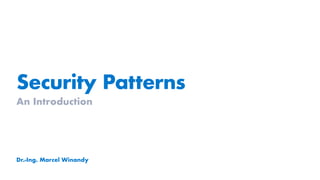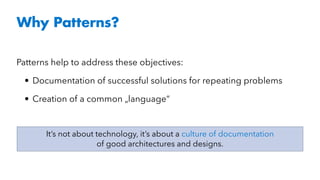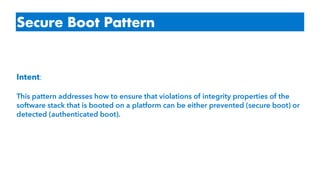The document introduces the secure boot pattern, which addresses ensuring the integrity of the software stack loaded on a platform. The pattern uses a chain of trust where each boot stage verifies the integrity of the next stage using cryptographic methods. The root of trust is a first module protected by hardware that verifies the initial integrity. The pattern provides security benefits while introducing complexity and overhead. Variants include authenticated boot, which detects instead of preventing integrity violations.








![Patterns for Secure Boot and Secure Storage in Computer Systems
Hans Löhr, Ahmad-Reza Sadeghi, Marcel Winandy
Horst Görtz Institute for IT Security, Ruhr-University Bochum, Germany
{hans.loehr,ahmad.sadeghi,marcel.winandy}@trust.rub.de
Abstract—Trusted Computing aims at enhancing the security
of IT systems by using a combination of trusted hardware
and software components to provide security guarantees. This
includes system state integrity and the secure link between
the software and hardware of a computing platform. Although
security patterns exist for operating system security, access
control, and authentication, there is still none of Trusted
Computing aspects. In this paper, we introduce security
patterns for secure boot and for secure storage, which are
important basic Trusted Computing concepts. Secure boot is
at the heart of most security solutions and secure storage is
fundamental for application-level security: it ensures that the
integrity of software is verified before accessing stored data.
Our paper aims at complementing existing system security
patterns by presenting the common patterns underlying the
different realizations of secure boot and secure storage.
Keywords-security patterns; trusted computing; secure boot;
secure storage;
I. INTRODUCTION
The literature on security patterns includes numerous
patterns related to operating systems, e.g., concerning au-
thentication and access control. However, until now, Trusted
Computing (TC) has received very little attention from
the pattern community. TC aims to employ a combination
of hardware security mechanisms and software to address
security problems that cannot be solved by software alone.
Particularly relevant among these are security threats related
to malicious software, such as Trojan horses and viruses.
By now, there is not only a tremendous amount of research
in this field, but TC concepts can also be found in a wide
variety of products, ranging from embedded devices, such as
mobile phones, to servers equipped with expensive tamper-
resistant secure co-processors. The best-known approach to
TC is based on the specifications released by the Trusted
Computing Group (TCG) [1].
In this paper, we present the patterns underlying two
fundamental TC concepts: secure boot and secure storage.
Secure boot guarantees that violations of integrity prop-
erties of the software stack that is booted on a platform
can be prevented, i.e., software that violates the integrity
properties cannot be loaded. A variant of this pattern, termed
authenticated boot, does not prevent software from being
loaded, but allows reliable verification of the load-time
integrity of the software that has been booted later on. Secure
boot is a building block at the heart of many TC-based
solutions (including implementations of secure storage).
Secure storage is a crucial application-level requirement
in many scenarios. Simple encryption is often not enough to
protect sensitive data: it must also be ensured that an attacker
cannot obtain the decryption key. Secure storage solves this
issue by using hardware (and software) to enforce access
restrictions on the stored data. Before access is granted to
an application, the integrity of the software is verified.
Secure storage and secure boot are essential concepts for
TC systems. For instance, a Common Criteria protection
profile for security kernels with TC support has been eval-
uated and certified recently [2], which also includes secure
boot and secure storage. The security patterns described here
could be helpful to implement these features for security
kernels that aim to comply with this protection profile.
This paper describes the common pattern underlying
various existing realizations of secure boot [3], [4], [1], [5],
and of secure storage [4], [1], [5].
II. SECURE BOOT PATTERN
Intent: This pattern addresses how to ensure that vio-
lations of integrity properties of the software stack that is
booted on a platform can be either prevented (secure boot)
or detected (authenticated boot).
A. Example
Consider a user who wants to use a computing device
that was left unattended or that was used by another person
before. How can the user be sure that the system software
is in the intended operational state, i.e., that no critical
component of the operating system or other software ap-
plications has been modified in a malicious or unauthorized
way? Typically, a file integrity checker program can check
the integrity of system and application files. However, any
file integrity checker program must rely on trusted reference
values and that those values have not been tampered with.
Moreover, the user wants also to be sure that the file integrity
checker itself is not tampered with or deactivated at all.
B. Context
Users of security-sensitive applications want to be sure
about the operational integrity of their applications and exe-
cution environment. Unauthorized changes to the application
code or the operating system may lead to unintentional
program behavior or violation of security goals. Users trust
the hardware, but they need a way to verify that the software
loaded on this hardware has not been tampered with.
Example
Secure Boot Pattern](https://image.slidesharecdn.com/security-patterns-220501224739/85/Security-Patterns-An-Introduction-9-320.jpg)













